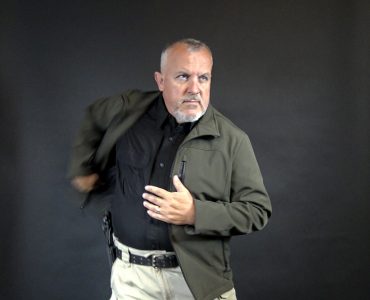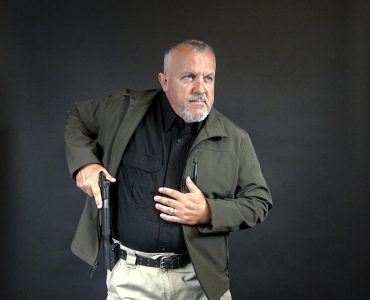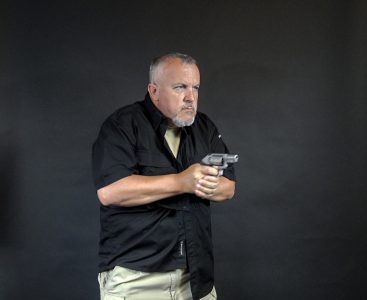
When it comes time to use lethal force, you only have seconds to respond. Make sure you can effectively get your gun in the fight.
Unlike what we see on television when a gun is drawn in self-defense, things happen pretty quickly. The fight starts at “A” and quickly progresses to “Z.” The time it takes you to get from A to B however is the factor that can dictate the outcome of a lethal force event. In more common terms, you have to get your gun into the fight quickly and accurately. A slow or sloppy presentation is akin to leisurely leaving the starting blocks when the starter’s gun goes off for a race. This is the case no matter where you carry your gun. While there are countless ways to carry, let’s look at two of the most common modes of carry (standard waistband carry and a pocket pistol) and how to effectively get them into the fight.
Clear!
The first task is to clear away your garment or any obstruction between you and your gun. For hip carry this will mean either pulling up a shirt or sweeping away a jacket. The key to success in this effort is to be deliberate and fast. If you are wearing a t-shirt, grasp the bottom of the shirt on both sides around the gun and pull directly up. Make certain to pull the shirt high to avoid it falling back down and interfering with your draw. For a jacket or cover shirt, use a curled fingers hand position to hook and throw the garment around towards your back. This sweeping motion should be sufficient to get the garment behind your gun without it coming back and impeding the draw.
Get the Grip
We now need to get your hand on the gun. The key to speed in this portion is economy of motion. If that terrible day should ever happen, a smooth draw stroke will win the day. This fact is one that should drive you to practice your draw. If you carry on the hip, you will need to really focus on clearing your concealed carry garment. If you carry in a pocket, your draw stroke will need even more practice. In order to get a pocket pistol into the fight you need to stab your finger into the pocket quickly and precisely. You will want to get your hand into a position that allows you to secure the handgun with as little extra movement as possible. A quick note regarding this style of carry. It is essential that you still use a holster designed for pocket carry. This prevents any foreign objects from possibly affecting the trigger. Additionally, the pocket you carry in should be dedicated to the pistol only. Do not put anything else in that pocket. One important thing to remember is that the grip you initially get on the gun should be the same grip you are shooting with. Readjusting the gun after it leaves the holster is time consuming and detrimental to accuracy. To get the best grip, come down onto the grip from an 11 o’clock angle. This puts your hand in line with the back strap of the gun and allows a straight path to the gun. The thumb should drive down the side of the gun as the hand moves into contact with the back strap. At this point your hand should be high on the back strap and firmly in contact with the gun. Proper position high on the back strap is critical for a fighting grip. Any excessive additional body motion should be avoided. While all of this is going on we are also going to multi-task and put our support hand flat on our abdomen just below the sternum. This is a preparation move for the moment we move both hands to the gun.
Clear the Holster and Angle In
With a solid grip, we now draw the gun straight up out of the holster. This is the case with either a hip or pocket holster. Once you have your grip, you must get the gun clear of the holster. In regard to pocket carry, this is why you will need to make sure the pocket you carry in is not overly tight or impedes a draw. Draw up high towards your armpit and then simply lower your elbow which brings the muzzle into the target. You are now in a close quarter fighting position should you need to engage one handed. The support side hand now begins to move across the body towards the gun so we can build our two-hand grip. You are now pointed in at the target which means any external safeties should come off and you will need to get your finger on the trigger in preparation.
On Target
It is time to start driving the gun towards the target and building our two-hand grip. In a smooth motion start pushing the gun forward towards the target while simultaneously adding the second hand to the grip. It is important that the support side hand get onto the gun quickly as it adds both stability and aids in us raising the sights into the target. The two should almost melt together and create a solid shooting grip. With the already established grip of the shooting hand, the support side hand should wrap around the shooting hand with the thumb down and towards the target. The shooting side thumb will rest on the meat of the support side thumb. With both hands on the gun we develop a 50/50 grip on the gun. Each hand applies equal pressure on the weapon. While you do not want to crush it, a firm grip on your gun will improve accuracy and overall shooting. We will also have equal pressure side to side on our gun. This helps us move smoothly from target to target.
Trigger Work

Once you have your grip established and the gun aligned on your target, it is time to engage the trigger.
The last part of this dynamic event is acquiring our sights and running the trigger. Practice good sight alignment and sight picture as you now begin to run the trigger. As you are driving the gun towards your final position you should already be taking the slack out of the trigger. This allows us to fire the weapon with only minimal trigger pressure at the end. This takes practice and training and is essential to getting shots downrange quickly and accurately. Once the slack is out and you are completely pointed in, then it is time to finish running the trigger. With one fluid smooth motion, press the trigger to the rear until the gun fires. Let the trigger reset and repeat as necessary. The trigger reset should be minimal as you want to avoid letting your finger travel back too far. We only need to get a reset of the trigger and anything more than that will slow down following shots.
Train
The steps required to quickly and efficiently get your gun into the fight require practice. If you are serious about concealed carry then it is essential that you get professional training and follow it up with ongoing practice. Like a martial arts kata, the draw stroke is one that takes practice to master. Once mastered it then requires ongoing practice to maintain an exceptional skill level. Without practice, our fluidity and speed will diminish which could have catastrophic effects. Remember that the idea that we will somehow “rise to the occasion” is not true in a gun fight. You will only be as good as your last training session.



